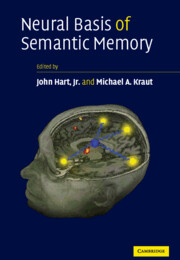Book contents
- Frontmatter
- Contents
- List of contributors
- Preface
- Part I Semantic Memory: Building Models from Lesions
- Part II Insights from Electrophysiology
- Part III Applications of Models to Understanding Cognitive Dysfunction
- Part IV Representations of Nouns and Verbs vs. Objects and Actions
- Part V Critical Role of Subcortical Nuclei in Semantic Functions
- Part VI Conceptual Models of Semantics
- Part 10 Process and content in semantic memory
- 11 The conceptual structure account: A cognitive model of semantic memory and its neural instantiation
- 12 Neural foundations for conceptual representations: Evidence from functional brain imaging
- 13 Neural hybrid model of semantic object memory (version 1.1)
- Index
- References
13 - Neural hybrid model of semantic object memory (version 1.1)
from Part VI - Conceptual Models of Semantics
Published online by Cambridge University Press: 14 September 2009
- Frontmatter
- Contents
- List of contributors
- Preface
- Part I Semantic Memory: Building Models from Lesions
- Part II Insights from Electrophysiology
- Part III Applications of Models to Understanding Cognitive Dysfunction
- Part IV Representations of Nouns and Verbs vs. Objects and Actions
- Part V Critical Role of Subcortical Nuclei in Semantic Functions
- Part VI Conceptual Models of Semantics
- Part 10 Process and content in semantic memory
- 11 The conceptual structure account: A cognitive model of semantic memory and its neural instantiation
- 12 Neural foundations for conceptual representations: Evidence from functional brain imaging
- 13 Neural hybrid model of semantic object memory (version 1.1)
- Index
- References
Summary
Delineating the neural bases of semantic memory, even for single entities (objects, features of objects, categories, actions, etc.) has been fraught with numerous difficulties, including variable definitions of semantic terms and several different models of the functional organization of semantic memory (see previous chapters). The development of new investigative techniques has been a major asset in detecting regions associated with semantic memory, but has not led to a consensus on semantic organization, since the results from these studies have frequently been discordant. For example, the results of activation studies (positron emission tomography, functional magnetic resonance imaging event-related potential – PET, fMRI, ERP, etc.), which demonstrate regions likely “involved” in performing a task, have yet to be fully integrated with the results of lesion-based studies that show regions “essential” for performing a task.
Historically, attempts at delineating the anatomic substrates of semantic memory have been guided by one of two general models or classes of models: parallel distributed representation (McClelland & Rumelhart, 1985 and Hinton, 1981) and center processing (Geschwind, 1965). It is clear, however, that neither of these models in their pure form explains adequately the growing body of data from anatomic and functional studies. In other words, the brain comprises neither a homogeneous network of equivalent neuronal elements that encode every aspect of a memory, nor circumscribed processing centers that encode all memory elements.
Keywords
- Type
- Chapter
- Information
- Neural Basis of Semantic Memory , pp. 331 - 360Publisher: Cambridge University PressPrint publication year: 2007
References
- 6
- Cited by

